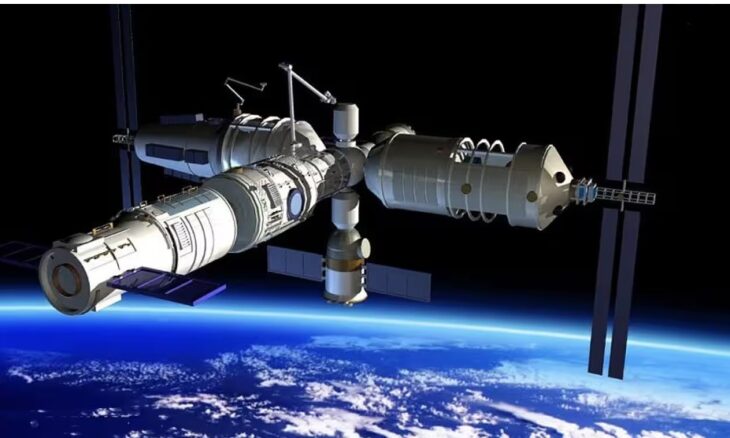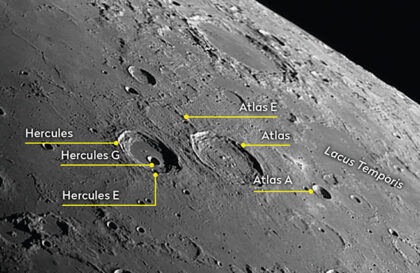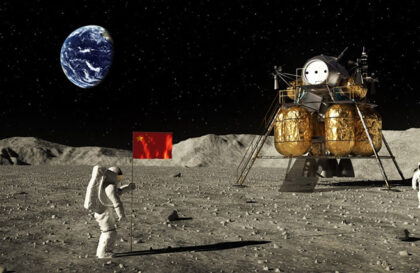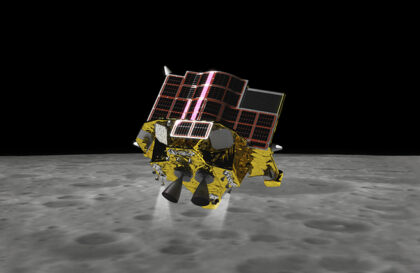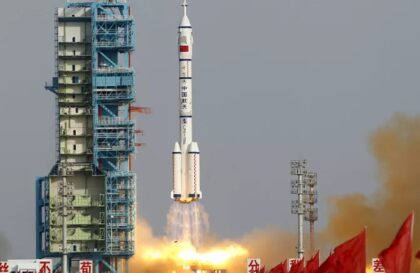Tiangong Space Station
In 2021, China began developing a large-scale orbital space station with a permanent crew designed to operate for more than ten years. This station became the third of its kind globally, following the “Mir” and the International Space Station (ISS).
The main module, “Tianhe,” was launched into orbit on April 29, 2021. In May 2022, the cargo spacecraft “Tianzhou-4” was launched, followed by the human-crewed “Shenzhou-14” in June.
In July of the same year, the laboratory module “Wentian” was launched and joined “Tianhe.” This module is unique in its features: it has a diameter of 4.2 meters, a length of 17.9 meters, a launch weight of 23 tons, and a robotic arm measuring 5 meters in length.
A rendering of the station with the Tianhe at center of picture, a Tianzhou on its aft port, the Wentian on its starboard port to the left, the Mengtian on its portside port to the right and two Shenzhou spacecraft, sharing its multi-docking hub
Another laboratory module, “Mengtian,” was launched in October 2022. Once attached to the other modules, the station will take on a ‘T’ shape. The working volume of the station will be 100 cubic meters, and the hermetically sealed volume will be 340 cubic meters (12,000 cubic feet), approximately one-third smaller than the ISS.
In the next phase, the optical module “Xuntian” is planned to be launched, featuring a space telescope with a 2-meter diameter mirror and a field of view 300 times larger than that of the Hubble Space Telescope, albeit with similar resolution. The module will periodically dock with the station for maintenance.
China is preparing for a space telescope and its space station. (Image credit: CSNA)
The orbital station’s weight, excluding the spacecraft, is estimated at 60 tons. The crew will consist of three or more astronauts, and each rotation will stay on board for three to six months.
The station’s orbital altitude will vary between 210 and 280 miles (340–450 kilometers), with an orbital inclination of 42-43 degrees. An automated cargo vessel is also planned for regular supply runs to the station.
Future development plans for the station include its further expansion with additional modules and platforms by 2025.
Orbital Station Systems
Power Sources
Two solar panels on each module generate the station’s electricity using gallium arsenide photovoltaic cells. Energy is stored for operation in shadow conditions. Cargo ships will replenish fuel to maintain orbit. The solar panels have a lifespan of up to 15 years.
Human-involved Hall-Effect Thrusters
The Tiangong space station uses traditional chemical and four ion thrusters to maintain its orbit. The ion thrusters have successfully undergone tests, operating for 8,240 hours without failure, and are designed for a 15-year service life. This is the first application of human-involved Hall-effect thrusters.
Robotic Equipment
The Tiangong station is equipped with five robotic arms for various tasks. The main module features a 10-meter Chinarm manipulator, while the Wentian module has a more precise 5-meter arm for extravehicular activities. The Mengtian module utilizes a mechanism for cargo movement and microsatellite deployment. Two additional manipulators are installed to assist in the station’s construction.
15 m combined robotic arm on Tiangong
The Tiangong station features five robotic arms. The longest among them is a 10-meter SSRMS manipulator of the Canadian type used on the ISS, nicknamed Chinarm, installed on the main module “Tianhe.”
Like the International Space Station, the Tiangong can be observed from Earth without a telescope. However, due to the station’s smaller size, its visibility will not be as bright as the ISS.
This is not China’s first orbital station.
Tiangong-1
Launched in an unmanned state on September 29, 2011, on a Long March 2F rocket, Tiangong-1 had a living volume of 15 cubic meters and used APAS docking mechanisms. It consisted of two parts: a resource module with solar panels and engines and an experimental module with exercise equipment and sleeping quarters. The interior walls had two colors for orientation in microgravity. The docked Shenzhou spacecraft provided life support systems, including the toilet and kitchen.
The station received three Shenzhou spacecraft from the 8th to the 10th missions, featuring China’s first female astronauts, Liu Yang and Wang Yaping.
Liu Yang became the first Chinese female in space in 2012
In 2016, China lost control of the station. It burned up in the atmosphere on April 2, 2018, over the Pacific Ocean. A fisherman observed this phenomenon from the neighboring island of Maupiti. Tiangong-1 became the largest object to uncontrollably re-enter the atmosphere since the fall of “Phobos-Grunt” in 2012. The event occurred about 3,600 km from Point Nemo, commonly used as a “graveyard” for decommissioned satellites. This uncontrolled re-entry was a coincidental occurrence.
Tiangong-2
Chinese astronauts Jing Haipeng, left and Chen Dong salute in the space lab Tiangong 2. Photograph: Ju Zhenhua/AP
Tiangong-2 was not designed as a long-term space station but as a platform for testing critically essential technologies. The station successfully launched on September 15, 2016, on a Long March 2F (Chang Zheng-2F) rocket from the Jiuquan Satellite Launch Center. Shenzhou-11, the only human-crewed mission to the station, docked with Tiangong-2 on October 19 of the same year.
On July 19, 2019, the object made a controlled descent into the atmosphere and disintegrated over the southern part of the Pacific Ocean.
The specifications of Tiangong-2 are as follows:
Crew:
Two astronauts with life-support resources for 30 days.
The team was aboard Shenzhou-11 on October 11, 2016.
Length: 10.4 meters (34 feet).
Maximum Diameter: 4.2 meters (14 feet).
Weight: 8,600 kilograms (19,000 pounds).
China’s near-term plans include developing a rocket capable of launching seven astronauts simultaneously.
Banner image: An artist’s rendition of the Chinese Large Modular space station. Photograph: Chinese News Service
Image credit:
https://www.theguardian.com
https://upload.wikimedia.org
https://upload.wikimedia.org
https://upload.wikimedia.org
https://en.wikipedia.org
https://en.wikipedia.org
https://www.theguardian.com
